News & Insights
Unlocking the potential of renewable natural gas
RNG is a growing carbon-neutral solution that utilizes emissions from waste to produce a renewable source of energy while directly reducing pollution to the atmosphere. This article explores why and how with practical examples and results.
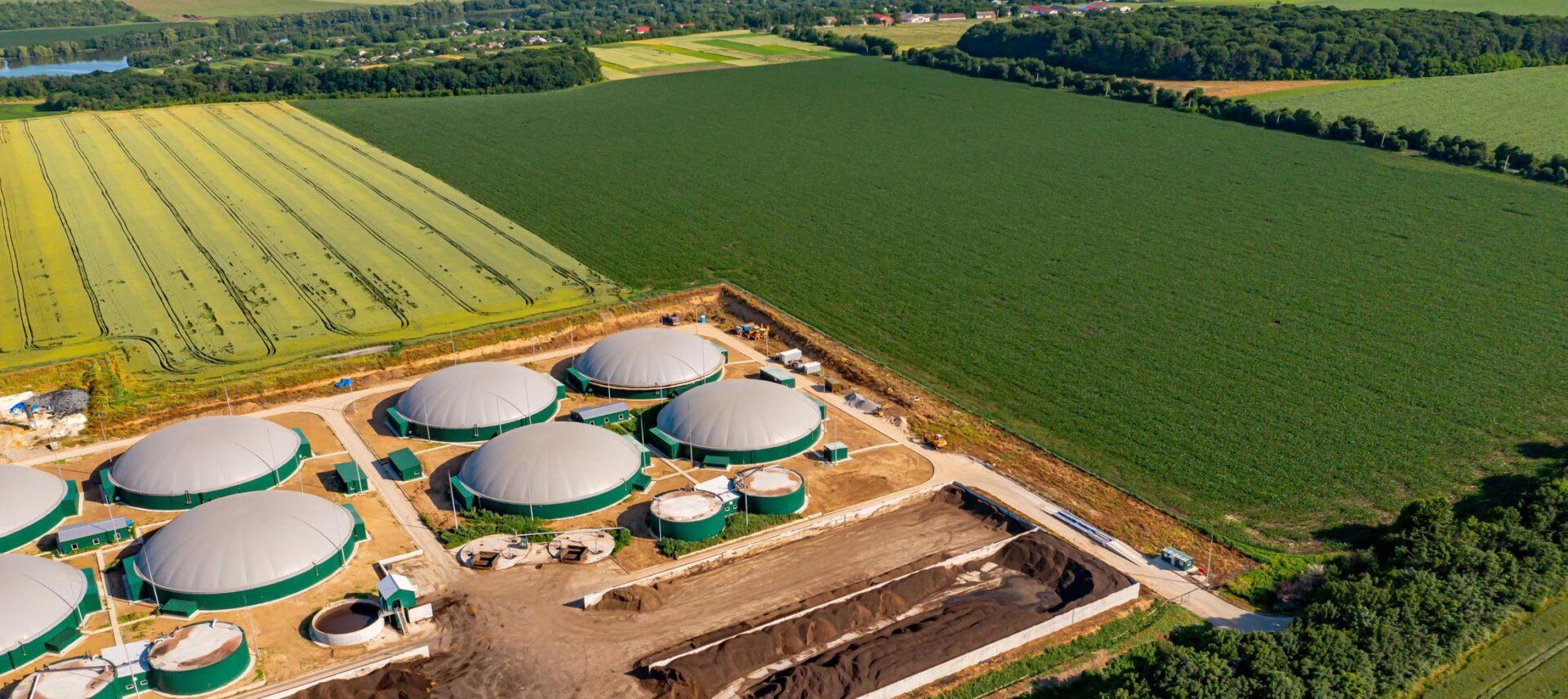
According to climate scientist Ilissa Ocko from her TEDx Talk, one percent of methane may cause more warming than all of CO2 in the next several years, but it only lasts in the atmosphere for around a decade. “Every time we reduce methane, we can reduce climate warming right away. Cutting methane is the single fastest, most cost-effective opportunity to immediately slow down the rate of climate warming.”
As of March of 2023, the EPA estimates that there are 466 good candidates for landfill natural gas projects in the United States. At Salas O’Brien, we see this as a distinct and ongoing opportunity to continue to support our partners and future projects in renewable natural gas.
What is renewable natural gas?
Renewable natural gas (RNG) projects capture and recover methane produced at a landfill or other methane-producing facility such as farms or digesters to prevent its release into the atmosphere, where it would otherwise contribute to greenhouse gas emissions. It is then transformed into a valuable, clean energy source that can be used to power homes, vehicles, and industrial processes.
Renewable natural gas is a term used to describe biogas that has been upgraded for use in place of fossil natural gas. The biogas used to produce RNG comes from a variety of sources, including municipal solid waste landfills, digesters at water resource recovery facilities, wastewater treatment plants, livestock farms, food production facilities, and organic waste management operations.
For gas utility owners, investment in RNG production provides a path to achieving methane emission reductions. Methane has a global warming potential at least 28 times greater than CO2 and a relatively short (12-year) atmospheric life, so reducing these emissions can achieve near-term beneficial impacts in mitigating global climate change. RNG facilities capture and utilize methane that farms, landfills, and other waste sources would otherwise vent into the atmosphere or incinerate in a flare.
Benefits of renewable natural gas
Harnessing RNG opens the door to a host of advantages from environmental, economic, and energy perspectives:
- Reduced greenhouse gas emissions. RNG captures methane emissions from decomposing organic waste, mitigating potent greenhouse gases that would otherwise contribute to climate change. RNG is considered a carbon-neutral solution that utilizes emissions to produce a renewable source of energy while directly reducing pollution to the atmosphere.
- Energy independence. By relying on local sources, RNG reduces the dependence on imported fossil fuels, mitigating supply chain disruptions. This enhances energy security by providing a more stable and predictable energy supply, especially when global fossil fuel markets are volatile.
- Effective waste management. Utilizing RNG reinforces proper waste management practices, diverting organic waste from landfills and promoting recycling and composting. This not only minimizes environmental impact but also promotes responsible resource use in local communities.
- Economic opportunities. From facility construction and operation to ongoing maintenance and technology development, RNG projects stimulate local economies, supporting a green workforce while attracting investment in sustainable industries.
- Advancing the circular economy. By transforming waste into a valuable energy resource, RNG reduces waste, minimizes emissions, and repurposes organic byproducts into clean energy. This closed-loop approach turns environmental challenges into economic opportunities.
- Energy diversification. Integrating RNG into the energy mix broadens the range of available energy sources, reducing dependence on traditional fossil fuels and accelerating the transition to cleaner, more resilient energy systems. This diversification enhances energy security.
- Seamless integration. RNG is compatible with existing infrastructure, such as natural gas-fired boilers and furnaces, providing a low-carbon alternative without requiring changes to current building systems or standard mechanical design practices. This allows for an easy transition to cleaner energy while maintaining operational efficiency.
- Infrastructure flexibility and expanding potential. RNG production sites are increasingly utilizing biogas by upgrading systems to connect directly to local pipelines or, where necessary, creating “virtual” pipelines to inject RNG into traditional networks. With over 400 landfills in the US capable of generating RNG and agricultural projects contributing significantly, the market for renewable gas is rapidly expanding.
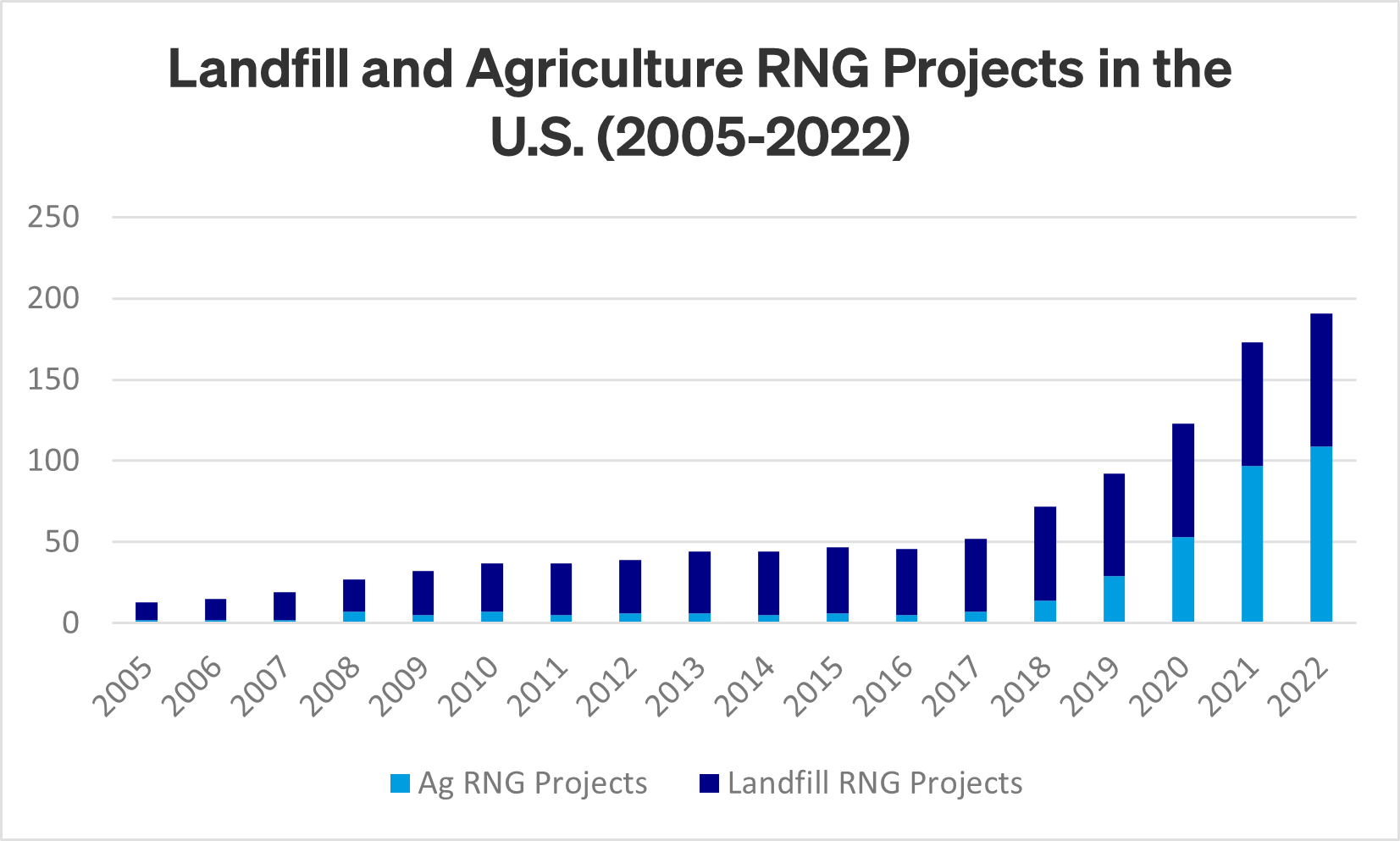
What is the financial payback of RNG projects?
The financial payback of RNG projects can vary depending on factors such as project size, initial investment, operational efficiency, market conditions for RNG, and government incentives or subsidies. Generally, RNG projects can have payback periods ranging from several years to a decade or more. However, a specific financial analysis is needed for each individual project to determine its related payback period.
Federal grant money is available for Renewable Energy Credits by offsetting traditional natural gas with renewable natural gas. The Environmental Protection Agency’s (EPA) RE-Powering Screening Dataset is a public database that estimates the potential for various renewable energy technologies that includes over 80,000 landfills, contaminated lands, and mining sites. The number of operational RNG facilities in North America reached 300 in July 2023, up from 30 in 2011. There are several programs available to both landfill and ag-based facility owners providing project development and financial assistance for the development of RNG projects.
There is a rate structure to compensate for the added cost to produce the renewable natural gas compared to the market on revenue grade natural gas. The benefit is to minimize the methane gas that is a key part of the greenhouse gases. Salas O’Brien works with international companies that need a US-based engineering firm to do work. Salas O’Brien will work with owners, project developers, and contractors to act as the US-based engineering firm to provide design services and ensure the proposed RNG systems comply with the appropriate local, state, and federal codes.

The landfill projects described in the table above were added to existing facilities where the methane generated by the landfill previously was incinerated in a flare to reduce overall emissions. The biogas is now sent through a series of treatment processes to remove the undesirable components of the gas stream to produce pipeline-quality renewable natural gas. The facilities are expected to operate with an uptime of approximately 94%, with shutdowns limited to annual maintenance and unexpected outages. Each facility is offsetting traditional natural gas CO2 emissions by creation of the RNG which shifts the creation of the CO2 emissions from the landfill flare system to final end users. The result of this process provides a useful benefit to the energy content of this captured biogas as opposed to simply incinerating through the flare system.
How Salas O’Brien can help with RNG solutions
Salas O’Brien offers the expertise and integrated solutions to help clients successfully navigate the complexities of renewable natural gas projects. From feasibility studies and site assessments to the design and implementation of biogas upgrading systems, we ensure seamless integration into existing infrastructure. Our multidisciplinary teams are experienced in optimizing RNG production and distribution, whether through local or virtual pipelines. By partnering with us, organizations can not only reduce their carbon footprint but also take advantage of the economic and energy security benefits of RNG.
Contact our contributors below to talk about your RNG project.
For media inquiries on this article, reach out to Stacy Lake, Director of Corporate Communications
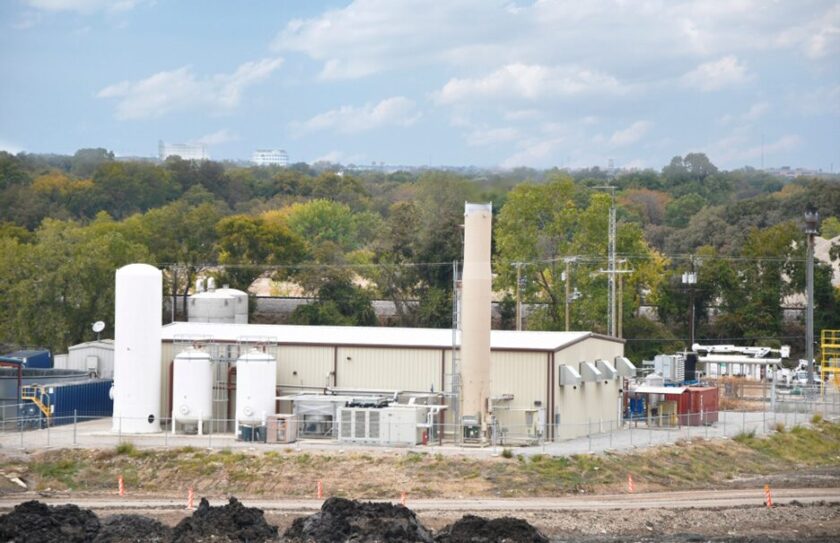
Renewable natural gas facility at existing landfill in Arlington, Texas
We partnered with Crowder Construction to perform MEP design, engineering, and construction administrative services for the installation of a new Renewable Natural Gas (RNG) Facility at an existing landfill in Arlington, Texas for Mas Energy. The new facility was designed to initially process approximately 3,000 SCFM of combined waste gas streams from the landfill and a nearby wastewater treatment plant and includes built-in capacity to increase throughput to 5,100 SCFM in the future. We performed early site-development studies, developed drawing packages for building permitting and construction, and assisted the design throughout the construction and commissioning of the project.
The project included the addition of a new 6,000 SF metal building to house the gas compression equipment and various membrane systems used to strip away siloxane and VOC-laden air streams as well as inert constituents including CO2 and N2. Additional process equipment was housed outdoors in the adjacent areas which include a new inlet blower system, H2S scrubber, activated carbon media tanks, thermal oxidizer, deoxygenation catalyst, glycol chillers, and various gas and lube oil coolers.
Our design services for the project included mechanical, electrical, process, and instrumentation and controls. Fire protection, building HVAC, and plumbing were included in the mechanical scope. Electrical services included utility coordination, primary site power feed, and power distribution design for the overall site. Process design included the development of PFD’s and P&ID’s, Process Hazards Analysis (HAZOP), site layout of equipment, and design of the piping systems. Lastly, we developed system architecture for the facility-wide controls, created I/O lists and instrument location plans, and designed the E-Stop control system for plant emergency shutdown.
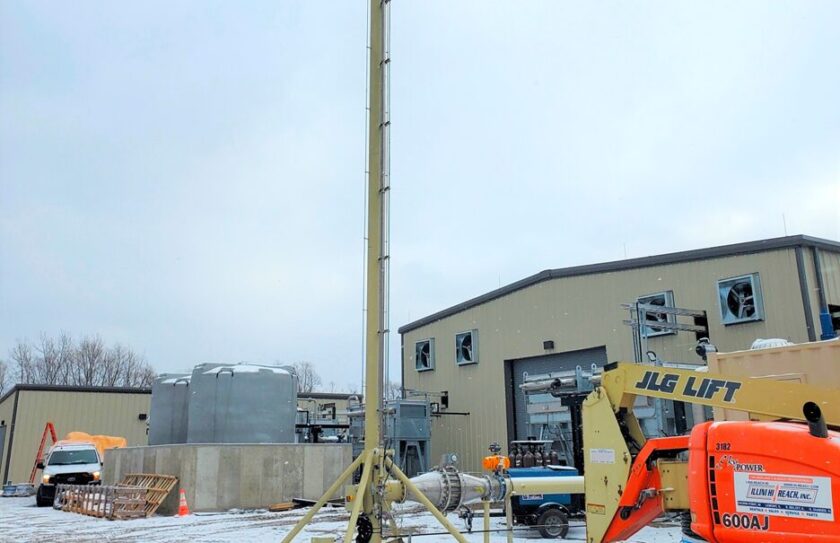
Countryside landfill RNG facility in Grayslake, Illinois
As the Prime Engineer on the project, we teamed with several design service professionals to design a new renewable natural gas facility at the Countryside landfill in Grayslake, IL. The facility is designed to produce approximately 1,555 SCFM of pipeline-quality natural gas from a raw landfill gas feed of 3,200 SCFM. The RNG facility is comprised of two separate buildings including a process building to house gas compression and treatment equipment and an electrical building to house electrical equipment and operator control room space. The process included a temperature swing adsorption system for the removal of Siloxanes and VOC’s and pressure swing adsorption systems for the removal of CO2 and N2. Additionally, an active scrubber system was provided for H2S removal of the raw landfill gas, and an oxidation catalyst system was provided for O2 removal of the product gas.
The multi-discipline team executed the balance of plant (BOP) work including all architectural, civil, structural, MEP, and controls design to incorporate the separate packaged systems into an integrated process design. The team worked with its construction partner to execute the work from the early stages of feasibility studies through detailed design and permitting and wrapped up with support during construction and startup.
The facility is expected to operate with an uptime of approximately 94%, with shutdowns limited to annual maintenance and unexpected outages.
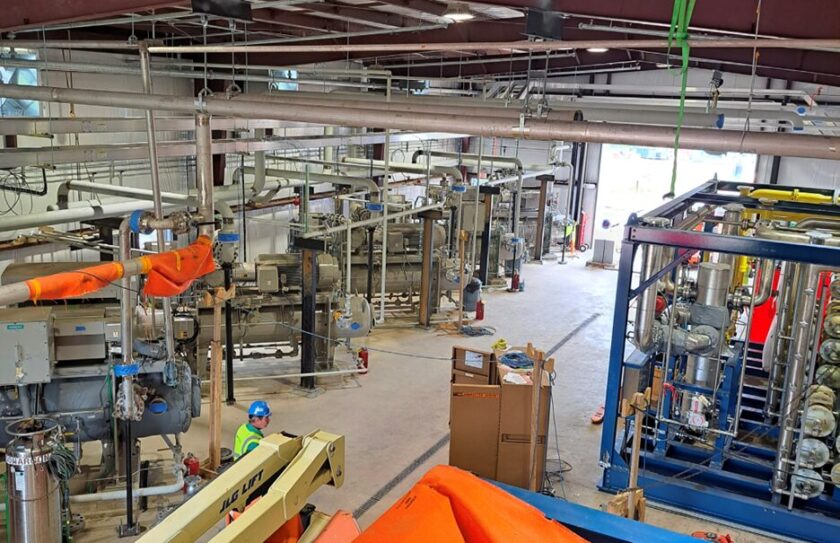
Wayne Township RNG facility in McElhattan, Pennsylvania
Working in a design-build project execution, we teamed with a construction partner to perform the balance of plant design for a renewable natural gas facility at a landfill in McElhattan, Pennsylvania. The addition of the RNG facility redirected approximately 2,500 SCFM of landfill gas that had previously been incinerated in a flare to a gas upgrading system used to produce roughly 1,333 SCFM of pipeline-quality natural gas.
Once through siting of the facility, we developed early design submissions with the design-build team to work through the process of obtaining building permits with the local authorities in an effort to support construction schedule.
We performed detailed design of the balance of plant (BOP) systems to integrate the various processes of gas compression, cooling, and gas upgrading into an overall plant design. We acted as the prime designer and coordinated the efforts of MEP, structural, civil, architectural, and instrumentation & controls design of the facility.
The result of this process provides a useful benefit to the energy content of this captured biogas as opposed to simply incinerating through the flare system.
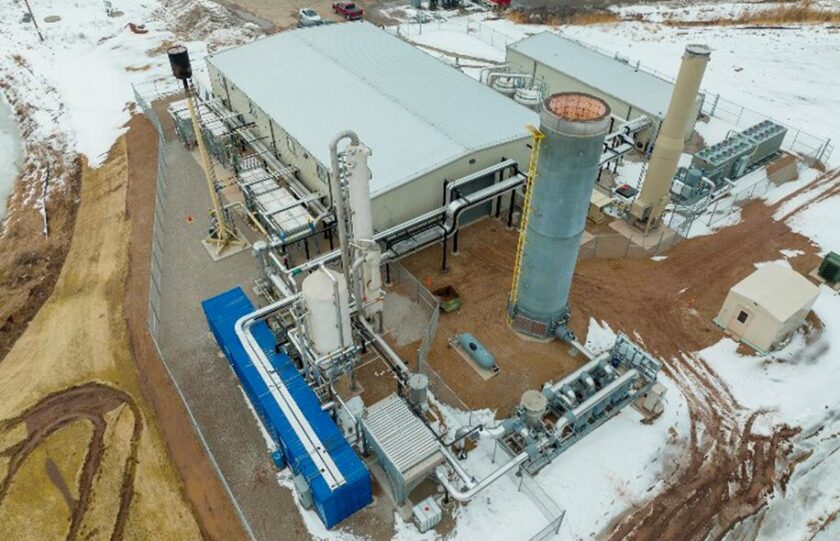
Outagamie RNG facility in Appleton, Wisconsin
We served as the Prime Engineer providing design services supporting Terreva Renewables and the County for this renewable natural gas facility. The stand-alone facility takes the raw methane from the landfill and houses the equipment necessary to convert it to pipeline-quality natural gas. By expanding the use of natural gas in the area to large commercial vehicles, this facility is anticipated to offset gasoline consumption by 4 million gallons, the equivalent to taking 7700 cars off the road.
The Outagamie County Recycling and Solid Waste Department landfill encompasses an area of 450 acres and provides services to residents of Brown, Outagamie, and Winnebago Counties. Landfill gas, a natural byproduct of landfill decomposition, is 28 times more potent than CO2 at increasing heat trapped in the atmosphere. As the third largest source of methane emissions in the United States, landfills such as this represent an opportunity to capture methane and prevent it from entering the atmosphere, while generating a high-quality renewable source of fuel.
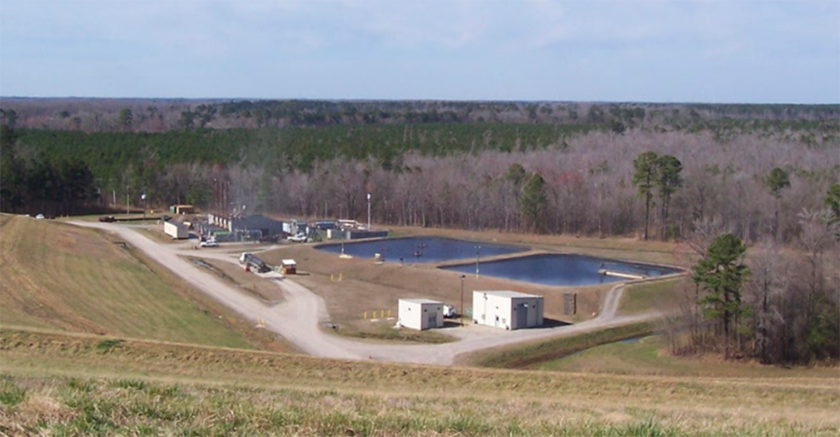
Southeastern Public Service Authority (SPSA) natural gas compression facility in Suffolk, Virginia
We worked together with the landfill gas treatment equipment vendors to design the balance of plant (BOP) systems to support the RNG plant including the design of piping systems, auxiliary process equipment, electrical systems, and overall plant controls & network design. The project included the addition of two (2) new buildings including a process building to house the gas compression and treatment systems as well as an electrical building provided with separate spaces for electrical distribution equipment and an operator control room.
We designed the high-pressure pipeline between the RNG facility and the utility tie-in including the addition of a new utility tap station comprised of final filtration equipment, custody transfer meter station, odorization systems, and over-pressure protection systems.
In addition to the tasks performed for the BOP process design, we provided design services to optimize siting of the new RNG facility and remote landfill blower system on the existing landfill. Additionally, we worked alongside their civil, architectural, and structural engineering subcontractors to develop site plans, utility plans, and MEP design for permitting the new buildings. We worked directly with plan reviewers during the development of the site to meet the requirements of local and state level jurisdictions. We also provided construction administration services during the construction, startup, and commissioning stages.

Ryan Mowery, PE
Ryan Mowery is a mechanical engineer specializing in industrial process and power. He is experienced in project management and design of power and steam generation systems, chilled water systems, thermal distribution systems, process piping, industrial HVAC, and plumbing. In addition, Ryan is specialized in the development of utility models to predict the energy usage and economic impacts associated with various district energy systems, including various combined heat and power (CHP) technologies. Ryan serves as a Principal at Salas O’Brien. Contact him at [email protected]

Jeff Lawrence, PE
Jeff Lawrence has heavy industrial and process engineering experience in renewable natural gas, chemical manufacturing, industrial buildings, building products, and the pulp and paper industries. He also specializes in process piping for design of new equipment at chemical manufacturing plants. Jeff serves as a Mechanical Engineer at Salas O’Brien. Contact him at [email protected]